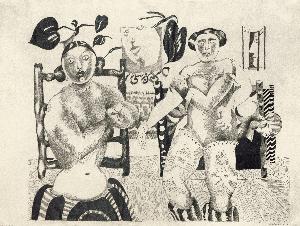Endre Rozsda
Endre Rozsda
Stil: Surrealism;
Mjesto: Mohács
Rođen: 1913
Smrt: 1999
Biografija:
Endre Rozsda (Hungarian: Rozsda Endre; 18 November 1913, Mohács – 16 September 1999, Paris) was a Hungarian-French painter. He was born in Mohács, a small city along the Danube in Hungary. His childhood memories marked his entire artistic work. The creative method he developed helped him to conjure a unique surrealistic world based on his memories. He acquired the basic skills of the trade in the school of Vilmos Aba-Novák. His first solo exhibition, held in the 'Tamás' gallery at age 23 (1936), was a great success. Critics praised his work and the Museum of Fine Arts, Budapest bought one of his paintings. His early artistic period, closely tied to Hungarian post-impressionism, came to an end after attending a Béla Bartók concert. Following the German occupation, he was forced to return to Budapest (1943) where his unique surrealistic style fully matured. After the war, he played an active role in the establishment of the European School and showed his work regularly in group shows. Following the suppression of the Hungarian Revolution of 1956 he permanently returned to France. He came into contact with Raymond Queneau and André Breton, who wrote an introduction for his exhibition at the ‘Furstenberg’ Gallery (1957). He participated in the International Exhibition of Surrealism in Milan (1961). A few years later he won the Copley-Prize (1964) from a jury composed of Hans Arp, Roberto Matta, Max Ernst, Man Ray, Roland Penrose, Sir Herbert Read and Marcel Duchamp. From the start of the 1960s, Rozsda's work underwent another change: the tensions and harmonies of architectonic structures and swirling colors created a richly detailed microcosm. In his effort 'to control time' and dissolve reality in his imagination he continued to rely on Surrealism, although his means of expression became increasingly characterized by lyrical abstraction.


